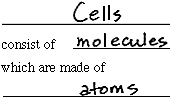Classroom Compass | |||||||||||||||||||||||||||||||||||||||
 |
The TIMSS Science Segment |
The following are sample items from the eighth-grade component of the TIMSS science segment. The entire science segment also included questions about environmental issues and the nature of science.
Earth Science
Life Science
Physics
ChemistryItems in the earth science category measure students' knowledge of the scientific principles related to earth features, earth processes, and the earth in the universe. In the Water Cycle question, students were asked to demonstrate their understanding by drawing a diagram. Internationally, students found this item to be rather difficult, with fewer than one-third of the responses showing a fully correct drawing. The next example was the most difficult earth science item. Only about one-quarter of students could identify the correct response nitrogen gas. The most common misconception, chosen by more than 50 percent of students, was that oxygen is the most abundant gas in air. Earth Science
Diagram of the Earth's Water Cycle (U.S. eighth-grade average correct: 40 percent)
Draw a diagram to show how the water that falls as rain in one place may come from another place that is far away.

Gases in Air (U.S. eighth-grade average correct: 20 percent)
Air is made up of many gases. Which gas is found in the greatest amount?
Arrow symbol indicates correct answer.

A. Nitrogen
B. Oxygen
C. Carbon Dioxide
D. Hydrogen
The TIMSS life science questions cover a broad range of content areas related to the structure, diversity, classification, processes, cycles, and interactions of plant and animal life. Internationally, fewer than half of the students selected the correct response about insect features. The heart rate question required students to design and communicate a scientific investigation. Fully correct responses described a procedure in which the pulse is measured at rest using a timer or watch, the individual engages in some type of physical activity, and then the pulse is remeasured during or after the exercise. Across countries, students found this item to be quite difficult, with only 14 percent of eighth-grade students, on average, providing a fully correct extended response. Life Science
Insect Features (U.S. eighth-grade average correct: 44 percent)
What features do all insects have?
Arrow symbol indicates correct answer.
No. of
LEGSNo. of
BODY PARTSA. 2 4 B. 4 2 C. 6 3 D. 8 3
Heart Rate Changes (U.S. eighth-grade average correct: 14 percent)
Suppose you want to investigate how the human heart rate changes with changes in activity. What materials would you use and what procedures would you follow?

Physics
Topics covered by the physics items include different energy forms, physical transformations, forces and motion, and the properties of matter. Internationally, the students found the flashlight question to be very difficult. This practical problem relates to the nature of light. The students needed to communicate that the same amount of light reaches the wall regardless of the distance the flashlight is from the wall. They may or may not have included the idea that the light becomes more or less spread out. On average, fewer than one-fourth of the students across countries correctly answered this item. A common misconception, identified by more than 30 percent of the student responses, was that a larger area of illumination means there is more light.
Flashlight Shining on Wall (U.S. eighth-grade average correct: 27 percent)
A flashlight close to a wall produces a small circle of light compared to the circle it makes when the flashlight is far from the wall. Does more light reach the wall when the flashlight is further away?
Arrow symbol indicates correct answer.

- No
- Yes
Explain your answer.
Chemistry
The chemistry items measured students' knowledge of topics related to chemical transformations as well as the chemical properties and classification of matter. The item below measured knowledge about the chemical make-up of cells. Internationally students found this short-answer–format item to be quite difficult, with about one-third of the eight-grade students providing the correct response.
Molecules, Atoms, and Cells (U.S. eighth-grade average correct: 29 percent)
The words cloth, thread, and fiber can be used in the following sentence: Cloth consists of threads which are made of fiber. Use the words molecules, atoms, and cells to complete the following sentence:Excerpts from: Beaton, A.E., et al. (1996) Mathematics achievement in the middle school years: IEA's third international mathematics and science study. Chestnut Hill, MA: TIMSS Intenational Study Center.
Classroom Compass Back Issues: Issue 3.3 Contents: Previous Next

